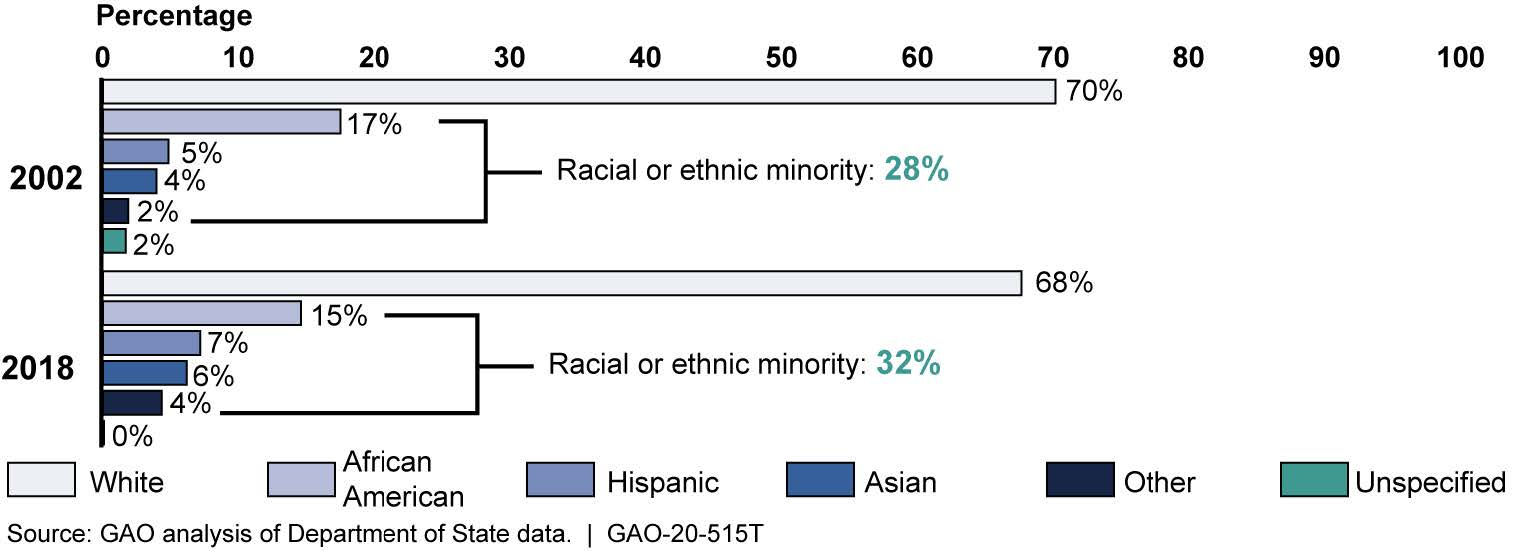State Department: Additional Steps Are Needed to Identify Barriers to Workforce Diversity
Fast Facts
The State Department has expressed a commitment to building a workforce that reflects the diverse composition of the United States. We testified on State’s progress.
Though State's workforce has grown more diverse, racial or ethnic minorities are still underrepresented, especially in the senior ranks.
Racial or ethnic minorities in State’s Civil Service were 4% to 29% less likely to be promoted than their white coworkers with similarities such as education, occupation, or years of federal service.
In our related report, we made a recommendation to help State better address barriers to equal opportunity in its workforce.

Hands
Highlights
What GAO Found
The overall proportion of racial or ethnic minorities in the Department of State's (State) full-time, permanent, career workforce grew from 28 to 32 percent from fiscal year 2002 to fiscal year 2018. The direction of change for specific groups varied. For instance, the proportion of African Americans fell from 17 to 15 percent, while the proportions of Hispanics, Asians, and other racial or ethnic minorities rose by varying percentages. The proportion of racial or ethnic minorities and women was lowest in the higher ranks of State's workforce.
Diversity in State Department Workforce in Fiscal Years 2002 and 2018

GAO's analyses of State data for fiscal years 2002 through 2018 found differences in promotion outcomes for racial or ethnic minorities and whites and for men and women. GAO found these differences in both descriptive analyses (calculating simple averages) and adjusted analyses (controlling for certain individual and occupational factors that could influence promotion). For example, GAO's descriptive analysis of data for State's Civil Service found that rates of promotion for racial or ethnic minorities were 16 to 42 percent lower, depending on the rank, than for whites. Similarly, after controling for certain additional factors, GAO's adjusted analysis of these data found that promotion for racial or ethnic minorites was 4 to 29 percent less likely than for whites. Also, both types of analysis generally found that promotion outcomes for women relative to men were lower in the Civil Service and higher in the Foreign Service. For example, women in the Foreign Service were more likely than men to be promoted in early to mid career.
State has identified some diversity issues, but it should consider other issues that could indicate potential barriers to diversity in its workforce. State's annual reports to the Equal Employment Opportunity Commission (EEOC) for fiscal years 2009 through 2018 identified issues such as underrepresentation of Hispanic employees and underrepresentation of minorities in the senior ranks. However, GAO's analysis and GAO's interviews with State employee groups highlighted additional issues that could indicate barriers to diversity. For example, State's reports have not identified lower promotion outcomes for racial or ethnic minorities relative to whites, which GAO found in its analysis. Until State takes steps to explore such issues, it could be missing opportunities to investigate and remove barriers that impede members of some demographic groups from realizing their full potential.
Why GAO Did This Study
State has expressed a commitment to maintaining a diverse workforce and has undertaken efforts to increase diversity in its Civil and Foreign Services. EEOC directs federal agencies to regularly evaluate their employment practices to identify barriers to equal opportunity, take measures to eliminate any barriers, and report annually on these efforts. This testimony examines (1) the demographic composition of State's workforce in fiscal years 2002 through 2018; (2) any differences in promotion outcomes for various demographic groups in State's workforce; and (3) the extent to which State has identified any barriers to diversity in its workforce. For the January 2020 report on which this testimony is based (GAO-20-237), GAO analyzed State's data for its full-time, permanent, career workforce in fiscal years 2002 through 2018. GAO also analyzed the number of years until promotion from early career ranks to the executive rank in both the Civil and Foreign Services. (GAO's analyses do not completely explain the reasons for differences in promotion outcomes, which may result from various unobservable factors. Thus, GAO's analyses do not establish a causal relationship between demographic characteristics and promotion outcomes.) In addition, GAO reviewed State documents and interviewed State officials and employee group representatives.
Recommendations
In its January 2020 report, GAO recommended that State take additional steps to identify diversity issues that could indicate potential barriers to equal opportunity in its workforce. State concurred with this recommendation.
